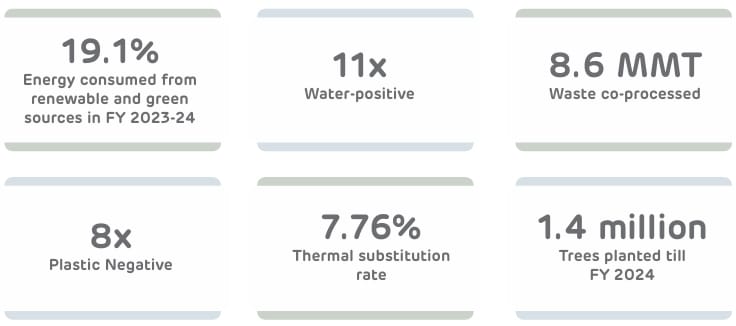Ambuja Cements Limited, the top cement and building materials company in India announced joining the Alliance for Industry Decarbonization (AFID). Ambuja’s membership marks a historic moment as it becomes the world’s first cement manufacturer to join AFID, setting a milestone in decarbonization for the cement industry.
Adani’s Acquisition and Significance of Joining the AFID
In September 2022, Adani Group completed the acquisition of Ambuja Cements Ltd and ACC Ltd. Thus, Ambuja Cements is now part of the growing Adani Portfolio. With its subsidiaries, ACC Limited and Sanghi Industries Limited, Ambuja Cements aims to help the Adani Group reach a cement production capacity of 140 MTPA by 2028.
Joining AFID is a significant milestone for the cement behemoth. Simply put, this global initiative aims to accelerate the transition to net zero as it aligns with the Paris Agreement. The AFID focuses on reducing emissions in industrial sectors and boosts the net-zero goals of the hard-to-abate industries. It brings together public and private organizations from energy-intensive industries to work toward a greener future. It serves as a platform for industry dialogue, fostering cooperation among private and public stakeholders in energy-intensive sectors.
By collaborating with other members, Ambuja aims to develop robust decarbonization strategies that align with national commitments. Notably, The International Renewable Energy Agency (IRENA) coordinates the alliance’s activities, ensuring a unified approach to achieving net-zero goals across industries.
Furthermore, the cement giant earned an A- ‘Leadership Score’ from CDP for its climate action. The company was also named one of ‘India’s Most Trusted Cement Brands’ by TRA Research in 2024 and listed among the ‘Iconic Brands of India’ by The Economic Times.
Currently, it has 18 integrated plants and 19 grinding units. Its highly advanced port infrastructure ensures timely, cost-effective bulk cement shipments, giving the company a competitive edge in the market.
Now, the big question is how Ambuja Cements plans to decarbonize its cement manufacturing process and achieve its Net Zero goals. What are its strategies and investments in renewable energy? Let’s explore.
Ambuja Cements: Leading the Way to Net Zero by 2050
Mr. Karan Adani, Non-Executive Director, Ambuja Cements.
“This marks another significant step for Ambuja in its sustainability journey. We are already amongst the lowest emission-intensity cement producers globally and are undertaking several strategic initiatives to further reduce our GHG emission footprint. Being a member of the Alliance for Industry Decarbonization would allow us to leverage the experiences of global cross-sector industry peers, and in turn, share our approach to decarbonization.”
Emission Reduction Target
Ambuja Cements, India’s second-largest cement producer with a capacity of 78.9 million tons per annum, has set a bold goal to achieve net zero emissions by 2050. Its targets are validated by the Science Based Targets initiative (SBTi). The company is committed to reducing greenhouse gas (GHG) emissions and is recognized as one of the lowest-emission cement producers globally.
- This year the company utilized over 8.6 million tonnes of waste-derived resources. It boldly highlighted being 11 X water-positive and 8 X plastic-negative.
Source: Ambuja Cements
Scope 1 and Scope 2 Emissions
The sustainability report explains how the company is combating its Scope 1 and Scope 2 emissions by 21% per ton of cementitious material by 2030. Notably, these efforts align with the Global Cement and Concrete Association’s roadmap for achieving Net Zero by 2050. The company has also conducted a climate risk assessment to ensure business resilience. They integrate recommendations from the Task Force on Climate-Related Financial Disclosures (TCFD).

The company has established an Internal Carbon Pricing (ICP) mechanism which is an integral part of its emission management strategy. This tool helps the company make informed decisions to reduce carbon emissions and fund low-carbon projects.
Mega Investment Plan in Renewable Energy
A key strategy to decarbonize the cement industry is the use of renewable energy. Ambuja Cements focuses on cutting energy consumption by harnessing solar and wind power, along with utilizing waste heat recovery systems (WHRS). At present, it has installed 76 MW of WHRS.
The press release reveals Ambuja Cements’ significant investment plan of approximately $1.2 billion (₹10,000 crore) in renewable energy projects. The company is targeting a total capacity of 1 gigawatt (GW) and an additional 376 megawatts (MW) from Waste Heat Recovery Systems (WHRS). This initiative will ensure that 60% of its expanded capacity will be powered by renewable energy by 2028.

Thus, all these efforts will significantly reduce the company’s carbon footprint and gain economic benefits through reduced energy costs and improved operational efficiency.



